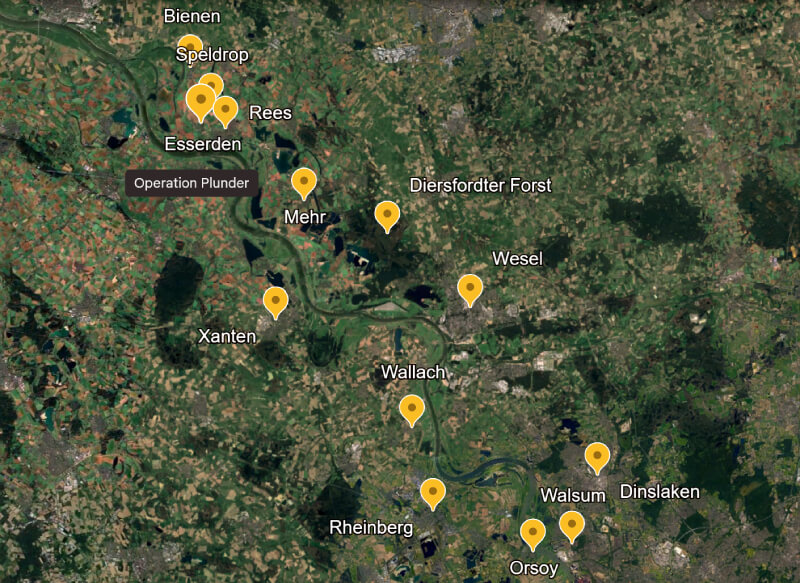| Page Created |
| March 17th, 2025 |
| Last Updated |
| April 14th, 2025 |
| United States |
 |
| Related Pages |
| 17th Airborne Division Airspeed Horsa WACO CG-4A General Aircraft Limited Hamilcar Jeep |
| March 24th, 1945 – March 25th, 1945 |
| Operation Varsity |
| Objectives |
- Denying German Forces access to the Diersfordterwald and facilitating rapid progress for the ground forces of Operation Plunder.
| Operational Area |

| Allied Forces |
- XVIII Airborne Corps
- 17th Airborne Division
| Axis Forces |
- 6. Fallschirmjäger-Division
- 7. Fallschirmjäger-Division
- 84. Infantrie Division
- 116. Panzer-Division, Windhund
- 180. Infantrie-Division
| Operation |
The 507th Parachute Infantry Regiment, commanded by Colonel Edson Raff, is the leading assault formation of the 17th Airborne Division and thus the first American airborne unit to participate in Operation Varsity. The regiment’s intended landing area, designated drop zone W, lies approximately 3 kilometres north of Wesel. However, heavy ground haze results in confusion among the transport aircraft pilots, causing the regiment to split into two distinct groups upon dropping. Colonel Raff, alongside about 690 paratroopers, lands northwest of the planned zone near the town of Diersfordt, while the remainder successfully reaches drop zone W. Raff quickly regroups his scattered men, leading them toward drop zone W, engaging and neutralising a German artillery battery en route. By 14:00, the regiment achieves all designated objectives and secures Diersfordt, neutralising numerous German defenders and destroying a German tank. During these engagements, Private George Peters earns a posthumous Medal of Honour by single-handedly neutralising a German machine gun nest, facilitating his comrades’ advance.
Wesel itself is heavily damaged by prior Allied bombardments.
The 513th Parachute Infantry Regiment, led by Colonel James Coutts, follows closely as the second airborne unit. During its approach to drop zone X, transport aircraft encounter significant German anti-aircraft fire, resulting in the loss of 22 aircraft and severe damage to another 38. Due to the same haze-induced pilot error experienced by the 507th Parachute Infantry Regiment, the 513th Parachute Infantry Regiment overshoots its intended drop zone, inadvertently landing in an area assigned to the British 6th Airlanding Brigade. Despite the deviation, the American paratroopers quickly consolidate and assist the simultaneously landing British glider troops. Together, they eliminate multiple German artillery positions before jointly capturing the town of Hamminkeln. By 14:00, Colonel Coutts confirms the regiment has met all its objectives, notably destroying two German tanks and neutralising two artillery regiments. Private First Class Stuart Stryker receives a posthumous Medal of Honour during these operations for bravely leading an assault on a German machine gun position, drawing fire and enabling his platoon to capture the fortified location.
The final component of the 17th Airborne Division involved in Operation Varsity is the 194th Glider Infantry Regiment, commanded by Colonel James Pierce. This regiment lands accurately at landing zone S but faces severe resistance from German anti-aircraft fire, resulting in the loss of 12 C-47 transport aircraft and damage to a further 140. Upon landing, the regiment is immediately engaged by nearby German artillery batteries actively firing at Allied ground forces crossing the Rhine. Despite this intense opposition, glider-borne infantry swiftly overcome the German batteries using direct assault tactics. The 194th Glider Infantry Regiment successfully reports achieving all objectives soon after landing, with a confirmed destruction of 42 artillery pieces, 10 tanks, 2 self-propelled anti-aircraft vehicles, and 5 self-propelled artillery guns.
| Multimedia |
